Name : Parveen Akhtar
Course – PERFORMANCE AND PRODUCTION ARTS – MMU Pathway
Level – 2/3
Project 3 – Make up for Screen
Deadline: Film and Scrapbook Submission – 3rd February 2023
Content Page
1 – Introduction (page-1)
2 – Proposal (project 3)
3 – Content (all on introduction page)
4 – Research (information/pictures on introduction page)
5 – How I have used my research (Youtube/Google, pictures, magazines)
6 – Mood-boards (to create my chosen looks)
7 – Rehearsal Pictures (Practice, Demos)
Practice with team members (students and actors)
9 – Risk assessment (Patch test)
10- Foundation types (scrapbook)
11- Concealer types (scrapbook)
12- Emmerdale (research)
13 – Edwardian era (scrapbook)
14 – Men’s Grooming (scrapbook)
15 – What is Vitiligo (scrapbook)
Introduction – Make up for Screen
What is the Project? This is a scripted TV production Project, in collaborating with Screen Yorkshire, (filming for – Inside No. 9)
What have I been asked to do? (what is my role) My role is to research and design a character form the tv series – Sardines that the performing school of art students have decided on, which will take place on Wednesday 18th January 2023.
Who is the client for this project? Screen Yorkshire
Information about the client? Filming for TV production.
Who is their audience? General Public
What skills am I bringing to this Production?
The skills I have gained from my previous projects of make up and hair style will boost my experience further with creating the make-up and hair of TV character, for the engagement party. I feel the skills I have gained from my previous project practices of, make up blending and choosing the right products for the type of look and the hair to go with it, this will take me one step further in my experience as a make up artist.
Context
1- Budget information (on the introduction page)
2 – Design Ideas (Mood-boards)
3 – Look ideas and design (research on Youtube, watch tv show for era etc)
4 – Marketing Ideas and Designs ( Mood boards)
5 – Feedback – (from obs and peer obs/ direction/ verbal/ tutors, actors and students)
6 – My Reflections (weekly updates)
7 – Evaluation (on over all project look)
8 – Aviva
9 – Reference list/ biography and links on introduction page/on other pages



Task to find out: How many different types of Foundations are there?
The different types of foundation
1- Cream Foundation
Cream foundations can offer you high coverage, so they’re great for covering up acne, scars, uneven skin tone, dark circles and any redness you may have. They’re also a good foundation for dry skin or mature skin as they can help skin to look smooth and soft. They give you a more silky coverage than liquid but can be prone to creasing. To avoid this, the key is to apply less than you would with liquid and blend well. For a medium coverage, apply with a damp beauty blender or for full coverage apply with a foundation brush. But remember to blend.
2- Mousse Foundation
Mousse foundation contains air which can make it lightweight and smooth on your skin but can also offer as much as a full coverage foundation. Along with a smooth texture, you’re sure to achieve a matte finish, meaning, like cream foundation, it can work best for dry, mature or sensitive skin. Again, mousse foundation can offer good coverage for acne prone skin and scars. Mousse foundation sounds similar to cream, which it is, the only differences being the coverage they offer and the amount of blending required. Apply mousse with fingers for a better distribution or for a more compact finish use a damp beauty blender.
3- Stick Foundation
Probably the most convenient of foundations and easy for on-the-go, as there’s no worry of an explosion in your bag. Convenience can be a contributing factor for having one, but that doesn’t always mean they’re right for your skin. Some foundation sticks can cause oily skin to produce more oils, but they do offer full coverage. Don’t take this as gospel though, as there will be some foundation sticks that specifically target oily skin. So it’s important to find the one that’s right for you. If you’re after a more natural look, then you’ll only need to apply a small amount to your skin and blend with either a beauty blender or a foundation brush. Then, finish with a powder of your choice. If you’re after the full coverage a foundation stick has to offer, then follow the same steps just apply more.
4- Mineral Foundation
Mineral foundation is what it says on the tin, foundation that contains minerals. This means it’s a lot kinder to sensitive skin and won’t clog your pores as there’s more room left for your skin to breathe. Mineral foundation is a good option for acne prone skin and is also rosacea-friendly. It doesn’t just come in powder form, it can come in liquid and compact form too so you’re able to pick one that works for you. Simply apply with either a compact, foundation brush or beauty blender depending on the form you’re using.
5 – Powder Foundation
Powder foundation is definitely one to use when you’re looking for minimal coverage and a light weight feel. There are many great things about powder foundation; it can work solo or as a setting powder on top of your foundation and is handy for having with you on-the-go to apply to any oily T-zone areas throughout the day. To apply, simply use the compact your product comes with or use any flat sponge and build as much coverage as you like.
6- Cushion Foundation
Not to be confused with powder foundation, cushion foundation is suited best for when you want more coverage than a BB or CC cream but less coverage than a foundation. They work great in building up as much coverage as you want that day and are a quick and easy solution if you’re on-the-go or miss your many alarms in the morning. The result should give you the perfect no-make-up, make-up look. Apply by using the compact your cushion foundation should come with and build to your desired coverage level. Tap the product in downward motions on your face for the ultimate blend.
7- Liquid Foundation
Liquid foundation tends to provide the most coverage and is best used if there are larger patches of skin you’re looking to even out. “For different skin types, it’s more about the ‘finish’ of the foundation than the ‘type’ of foundation—I prefer using liquid foundations on all skin types because it can look most like real skin,” says Melissa Murdick, celebrity makeup artist and creator of The Pretty Fix, an organization that educates transgender folks on makeup.
8- Tinted Moisturiser
Tinted moisturizer tends to have sheer coverage and may not be ideal for masking heavy discoloration or blemishes. However, it’s amazing for creating a bright, dewy complexion and evening skin tone. This is also a great lightweight option for summer. “I go for more glowy products for dry or mature skin (because both skin types tend to look dull), and more natural finish for oily skin.
9 – BB Cream
Perfect for a broad range of skin types, BB cream stands for “blemish balm” or “beauty balm.” It’s made with a relatively creamy formulation and can help even skin tone while moisturizing skin and providing just a touch of color. If you are prone to oil and blemishes, don’t run: “Contrary to what most people would choose, I almost never use matte finish products for oily skin types,” says Murdick. “They look too flat, powdery, or makeup-y in my opinion. If someone has oily skin, I’ll start with a magnifying primer and then use a natural finish foundation (plus a bit of powder as needed).”
10- CC Cream
Similar to BB cream, CC cream (which stands for “color correcting”) is intended to provide a light layer of coverage with a natural tint. These creams are often hydrating and frequently contain anti-aging ingredients. Just like their alphabetical predecessor, CC creams can help even skin tone to create a bright, fresh-faced look. To apply CC cream or another liquid foundation, “I love to use a brush for application to save the amount of foundation and buff in the product. After, I use a moist sponge to set powder and keep the skin as fresh and satin as possible.
The Different Types of Concealers and Their Uses
Each of these types of concealers works for different skin types or skin concerns. So, let’s delve deeper into each type of concealer. Liquid concealer is one of the most versatile types of concealer because it can offer either sheer- or full-coverage, depending on the exact formula. This type of concealer is fantastic for almost all skin types.
There are quite a lot of concealer formulas available, so it is easy to get confused when shopping for one. For simplicity’s sake, let’s divide them into four main categories:
- Liquid concealer
- Cream concealer
- Balm concealer
- Stick concealer
Liquid Concealer
Liquid concealer is one of the most versatile types of concealer because it can offer either sheer- or full-coverage, depending on the exact formula.
This type of concealer is fantastic for almost all skin types. People with dehydrated (or very dry) skin should stay away from liquid concealers as they can emphasize the dry patches and look flaky. However, normal and oily skin types can use it without issues.
Liquid concealer is great for covering blemishes and dark circles because it will seamlessly blend into your skin and doesn’t emphasize fine lines and or creases as much as other types of concealer.
Liquid Concealer Finishes
There are three types of liquid concealer finish: matte, satin and radiant.
A matte finish will last longer and reduce shine; it will stay put for longer. However, it is more likely to emphasize the dryness of the skin and maybe even cause dry patches.
A satin finish concealer gives a more natural look or finish. If you are into a no-foundation look and want to correct small imperfections, a satin concealer is perfect for you.
A radiant finish concealer is fantastic for under eyes because it can cover the dark circles, and highlight the area and provide a soft glow. If you go with a radiant liquid concealer, only use small amounts at a time and try not to overdo it.
Cream Concealer
Cream concealers usually provide medium- to full-coverage and its texture is thicker than a liquid foundation. Cream concealers are perfect for dark under eye circles and covering discolorations.
This type of concealer is best applied by stippling with your finger as the warmth of your hand will make the concealer easier to work with. However, it works fine with a beauty sponge or a concealer brush too.
Cream concealers are fantastic for covering blemishes that dried out, as it won’t emphasize the dry patches on your skin. However, keep in mind that they tend to crease, so they may not be the best choice for people with fine lines or wrinkles. They
Balm Concealer
Balm concealers are thicker in texture and tend to stay where they are throughout the day, making this type of concealer perfect for people who have an oily skin type.
Many of balm concealers are also color correctors, which are typically used under the foundation to neutralize the discoloration or redness. Now, there’s a lot of confusion when it comes to color correctors, so let’s break it down a little:
- Peach color concealers neutralize blue and purple shadows on medium skin tones.
- Orange/pink concealers neutralize dark spots on dark skin tones, pale pink conceals blue spots on fair skin.
- Yellow concealers cover purple or darker shadows on olive or tan skin.
- Green concealers hide redness.
- Lavender/purple concealers cancel out the yellowness.
Stick Concealer
Stick concealers get their name from the way they are packaged – in the form of a stick. Its texture is creamy and thick. Cosmetically, it leaves a very pigmented and vibrant look
This type of concealer is fabulous for covering dark spots and blemishes, and touch-ups. Stick concealers need to be blended a lot, so it is best to apply it with stippling motions with a finger, brush, or beauty sponge, feathering out the edges into the skin.
Even though they offer the fullest coverage out of all the concealer types, they tend to be quite heavy, so if you have sensitive or very oily skin, you might want to consider a different concealer type. For example, if you have oily skin, definitely avoid stick concealers in the summertime, as the heat can make it move all over your face and completely melt.
Bonus: Concealer With SPF
Sun protection is the most crucial step in your daily beauty routine, so why not choose a concealer with SPF? They are a bit rarer, so you may need to search for the perfect one for a while.
SPF beauty products can help prevent discoloration from the sun, wrinkles, and more. Also, they tend to be more moisturizing too – making them an overall great concealer for all skin types!
Types of Concealer: The Different Types and Their Uses (cosmeticsandbeauty.net)
About Edwardian era

Description
The Edwardian era or Edwardian period of British history spanned the reign of King Edward VII, 1901 to 1910 and is sometimes extended to the start of the First World War. The death of Queen Victoria in January 1901 marked the end of the Victorian era. Her son and successor, Edward VII, was already the leader of a fashionable elite that set a style influenced by the art and fashions of continental Europe. Samuel Hynes described the Edwardian era as a “leisurely time when women wore picture hats and did not vote, when the rich were not ashamed to live conspicuously, and the sun really never set on the British flag.”[1]
The Liberals returned to power in 1906 and made significant reforms. Below the upper class, the era was marked by significant shifts in politics among sections of society that had largely been excluded from power, such as labourers, servants, and the industrial working class. Women started to play more of a role in politics.[2]
The Edwardian era was the last period of British history to be named after the reigning monarch. The subsequent reigns of George V and George VI are not commonly termed Georgian era, this name being reserved for the time of the 18th-century kings of that name. Similarly, Elizabethan era refers solely to the 16th-century queen Elizabeth I and was not extended to the reign of Elizabeth II.
Perceptions[edit]
The Edwardian period is sometimes portrayed as a romantic golden age of long summer afternoons and garden parties, basking in a sun that never set on the British Empire. This perception was created in the 1920s and later by those who remembered the Edwardian age with nostalgia, looking back to their childhoods across the abyss of the Great War.[3] The Edwardian age was also seen as a mediocre period of pleasure between the great achievements of the preceding Victorian age and the catastrophe of the following war.[4]
Recent assessments emphasise the great differences between the wealthy and the poor during this period and describe the age as heralding great changes in political and social life.[2][5] Historian Lawrence James has argued that the leaders felt increasingly threatened by rival powers such as Germany, Russia, and the United States.[6] Nevertheless, the sudden arrival of World War I in the summer of 1914 was largely unexpected, except by the Royal Navy, because it had been prepared and ready for war.
Social change and improved health[edit]
By the late-1880s, the Industrial Revolution had created new technologies that changed the way people lived. The growth of industry shifts in manufacturing factories, special-purpose machinery and technological innovations, which led to increased productivity. Gender roles shifted as women made use of the new technology to upgrade their lifestyle and their career opportunities.
Mortality declined steadily in urban England and Wales 1870–1917. Robert Millward and Frances N. Bell looked statistically at those factors in the physical environment (especially population density and overcrowding) that raised death rates directly, as well as indirect factors such as price and income movements that affected expenditures on sewers, water supplies, food, and medical staff. The statistical data show that increases in the incomes of households and increases in town tax revenues helped cause the decline of mortality.[52]
The new money permitted higher spending on food, and also on a wide range of health-enhancing goods and services such as medical care. The major improvement in the physical environment was the quality of the housing stock, which rose faster than the population; its quality was increasingly regulated by central and local government.[52] Infant mortality fell faster in England and Wales than in Scotland. Clive Lee argues that one factor was the continued overcrowding in Scotland’s housing.[53] During the First World War, infant mortality fell sharply across the country. J. M. Winter attributes this to the full employment and higher wages paid to war workers.[54]
Rising status of women[edit]
Oilette postcard with art by Phil May, published by Raphael Tuck & Sons, circa 1910s
For housewives, sewing machines enabled the production of ready-made clothing and made it easier for women to sew their own clothes; more generally, argues Barbara Burman, “home dressmaking was sustained as an important aid for women negotiating wider social shifts and tensions in their lives.”[55] Increased literacy in the middle class gave women wider access to information and ideas. Numerous new magazines appealed to her tastes and helped define femininity.[56]
The inventions of the typewriter, telephone, and new filing systems offered middle-class women increased employment opportunities.[57][58] So too did the rapid expansion of the school system,[59] and the emergence of the new profession of nursing. Education and status led to demands for female roles in the rapidly expanding world of sports.[60]
Women were very active in church affairs, including attendance at services, Sunday school teaching, fund raising, pastoral care, social work and support for international missionary activities. They were almost completely excluded from practically all leadership roles.[61]
Fashion[edit]
Further information: 1900s in fashion
A cartoon in Punch (1911) compares changes in fashion between 1901 and 1911. “The dowdy voluminous clothes of the earlier date, making the grandmother an old lady and the mother seem plain, had been replaced by much simpler looser wear producing a sense of release for all three females.”[75]
The upper classes embraced leisure sports, which resulted in rapid developments in fashion, as more mobile and flexible clothing styles were needed.[76][77] During the Edwardian era, women wore a very tight corset, or bodice, and dressed in long skirts. The Edwardian era was the last time women wore corsets in everyday life.[citation needed] According to Arthur Marwick, the most striking change of all the developments that occurred during the Great War was the modification in women’s dress, “for, however far politicians were to put the clocks back in other steeples in the years after the war, no one ever put the lost inches back on the hems of women’s skirts”.[78]
Fabrics were usually sweet pea shades in chiffon, mousse line de sore, tulle with feather boas and lace. ‘High and boned collars for the day; plunging off shoulder décolleté for the evening’.[79] The tea gown’s cut was relatively loose compared to the more formal evening gown, and was worn without a corset. The silhouette was flowing, and was usually decorated with lace or with the cheaper Irish crochet.[80]
Long kid gloves, trimmed hats, and parasols were often used as accessories. Parasols are different than umbrellas; they are used for protection from the sun, rather from the rain, though they were often used as ornamentation rather than for function. By the end of the Edwardian era, the hat grew bigger in size, a trend that would continue in the 1910s.
The Edwardians developed new styles in clothing design.[81] The Edwardian Era saw a decrease in the trend for voluminous, heavy skirts.[82]
- The two-piece dress came into vogue. At the start of the decade, skirts were trumpet-shaped.
- Skirts in 1901 often had decorated hems with ruffles of fabric and lace.
- Some dresses and skirts featured trains.
- Tailored jackets, first introduced in 1880, increased in popularity and by 1900, tailored suits known as tailormades became popular.[83]
- In 1905, skirts fell in soft folds that curved in, then flared out near the hemlines.
- From 1905 – 1907, waistlines rose.
- In 1911, the hobble skirt was introduced; a tight fitting skirt that restricted a woman’s stride.
- Lingerie dresses, or tea gowns made of soft fabrics, festooned with ruffles and lace were worn indoors.[84]
- Around 1913 women’s dresses acquired a lower and sometimes V-shaped neckline in contrast to the high collars a generation before. This was considered scandalous by some, and caused outrage among clergy throughout Europe.[85]
Newspapers[edit]
The turn of the century saw the rise of popular journalism aimed at the lower middle class and tending to deemphasise highly detailed political and international news, which remain the focus of a handful of low-circulation prestige newspapers. These were family-owned and operated, and were primarily interested not in profits but in influence on the nation’s elite by their control of the news and editorials on serious topics.[86]
The new press, on the other hand, reached vastly larger audiences by emphasis on sports, crime, sensationalism, and gossip about famous personalities. Detailed accounts of major speeches and complex international events were not printed. Alfred Harmsworth, 1st Viscount Northcliffe was the chief innovator.[86] He used his Daily Mail and Daily Mirror to transform the media along the American model of “Yellow Journalism“. Lord Beaverbrook said he was “the greatest figure who ever strode down Fleet Street”.[87] Harmsworth made a great deal of money, but during the First World War he also wanted political power. For that he purchased the highest prestige newspaper, The Times.[88] P. P. Catterall and Colin Seymour-Ure conclude that:
More than anyone [he] … shaped the modern press. Developments he introduced or harnessed remain central: broad contents, exploitation of advertising revenue to subsidize prices, aggressive marketing, subordinate regional markets, independence from party control.[89]

Music[edit]
Live performances, both amateur and professional, were popular. Henry Wood, Edward Elgar, Gustav Holst, Arnold Bax, George Butterworth, Ralph Vaughan Williams, and Thomas Beecham were all active. Military and brass bands often played outside in parks during the summer.[92] The new technology of wax cylinders and gramophone records played on phonographs and talking machines, made live performances permanently available for repetition at any time.
Performing arts[edit]
Cinema was primitive and audiences preferred live performances to picture shows. Music hall was very popular and widespread; influential performers included male impersonator Vesta Tilley and comic Little Tich.[93]
The most successful playwright of the era was W. Somerset Maugham. In 1908, he had four plays running simultaneously in London, and Punch published a cartoon of Shakespeare biting his fingernails nervously as he looked at the billboards. Maugham’s plays, like his novels, usually had a conventional plot structure, but the decade also saw the rise of the so-called New Drama, represented in plays by George Bernard Shaw, Harley Granville Barker, and Continental imports by Henrik Ibsen and Gerhardt Hauptmann. The actor/manager system, as managed by Sir Henry Irving, Sir George Alexander, and Sir Herbert Beerbohm Tree, was in decline.
Film[edit]
Filmmakers Mitchell and Kenyon documented many scenes from Britain and Ireland from 1900 to 1907, sports, parades, factory exits, parks, city streets, boating and the like. Their films have survived in very good quality restored from the original negatives.[96][97]
The Edwardian ideal: Gibson Girl
A classic Edwardian Woman was very much aware of fashion and this era brought some extraordinary new changes in fashion. The Gibson girl was a major fashion influencer of Edwardian women. The Gibson girl was a pen and ink illustration by artist Charles Dana Gibson (1867– 1944). At the beginning of 1900, the Industrial Revolution started to create more job opportunities by making manufactured goods available. Middle-class women, along with the poor women started to work outside. Women needed to be fashionable as well as active. In the early twentieth, simpler yet practical dresses became more preferable as working class clothes. Long skirts and outfits with high necks and well-fitting sleeves became popular. These dress styles attracted artist Charles Dana Gibson and he created the Gibson girl.
The Gibson girl happened to be tall, sporty, and gracious. Sometimes she was portrayed at a desk in a custom-made shirtwaist or sometimes playing tennis in a casual sports costume. She used to style hair with a simple hat. She was skillful and self-determining, also attractive and well-dressed.
The popularity of Gibson girl fashion spread quickly. Women from all classes desired to follow the Gibson girl dress patterns. Women started to imitate the styles from the picture and The Gibson Girl became one the major fashion icon in the Edwardian era.

The defining hairstyle for Edwardian women was the pompadour. It is named after Madame de Pompadour (chief mistress of Louis XV in the mid-1700s), although the Edwardian version is fuller.
The full pompadour is high, rounded and curved away from the head. Creating this shape meant backcombing and rolling a woman’s long hair into the desired form. Matted pads or rolls of hair (known as “rats”) were to support the hairstyle. They could also use a pompadour wireframe.
Ultimately, there were many ways to dress a pompadour. For example, the hair could be straight, have a wave or be curled. Likewise, the hair could feature decorative elements like a top bun, soft coils, and fuzzy curled fringes.


The Low Pompadour
This version of the pompadour was dressed full and high at the front. However, the hair was not piled on top of the head. Instead, the bulk of the hair was dressed at the back.
As with the full pompadour, this style had many ways to be completed. A series of coils and puffs or a French bun were all popular. It was known in hairstyling books and publications for ladies as a “low coiffure”.

Hair Accessories
A fashionable lady would always wear decorative hair accessories to evening functions and for special occasions. However, while it was fashionable to wear accessories, polite society considered it unnecessary to wear too many items at once.
Bows & Ribbons
Ribbons created bows to attached to the hair. They were worn at the nape or tied on the end of a teenager’s plait. Bows were large and a prominent accessory.
Black was the most commonly seen colour. Velvet was a popular material for ribbon, as was taffeta and tulle.
Braids
Braids were a popular element for both women and girls. Switches could also be used to add a braid to a hairstyle.
Combs
Combs were both decorative and functional, with two or three keeping the hair in place for the day. The large Mantilla combs (usually worn at the back of the head) were often highly decorated with coloured stones, baroque pearls and gold filigree.
New plastic materials were replacing the traditional materials of ivory, bone, tortoiseshell and horn. For instance, celluloid and Bakelite were not only cheap, but easy-to-mould materials that could be produced in various colours.



False Hair & Wigs
False hair was commonly used to adorn or bulk out the large pompadour styles. Switches and clusters could add decorative detail, such as a chignon or braid. Likewise, women could buy fake ringlets and fuzzy fringes (known as a frisette). Wigs (or transformations as known then) were not uncommon.
The big Edwardian hairstyles required large amounts of hair – and not everyone was naturally blessed with rivers of hair. However, false hair was used with discretion in mind. In short, fake hair was not to be noticed and blended into the hair.
Men’s Pompadour Hairstyles
Pompadour is very popular in men too, such as Elephant Trunk, Classic, Ducktail, messy. Elvis Presley and Teddy Boy were few of popular stars with Pompadour hair styles.
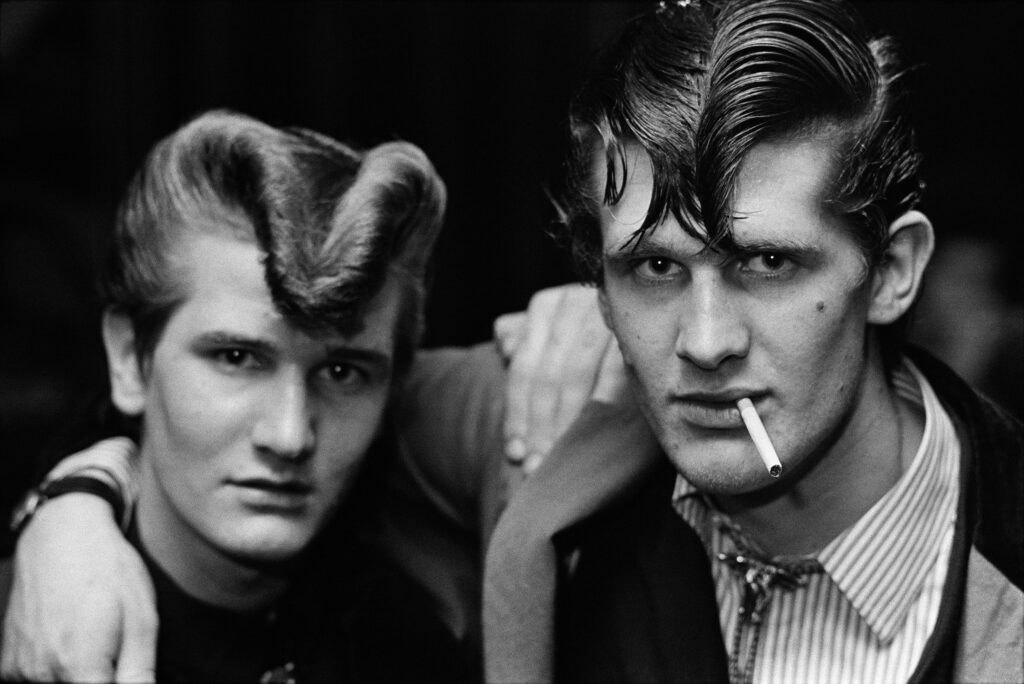
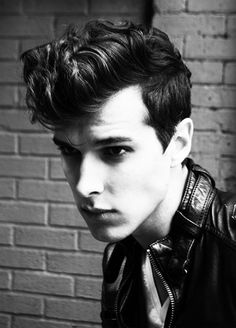
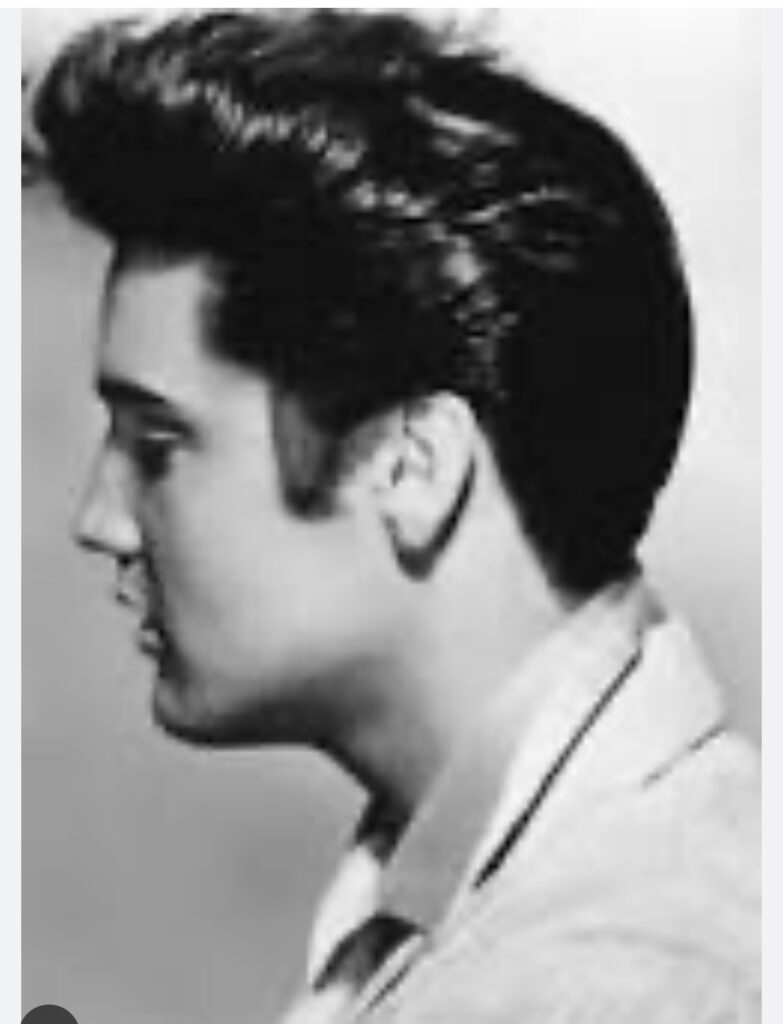
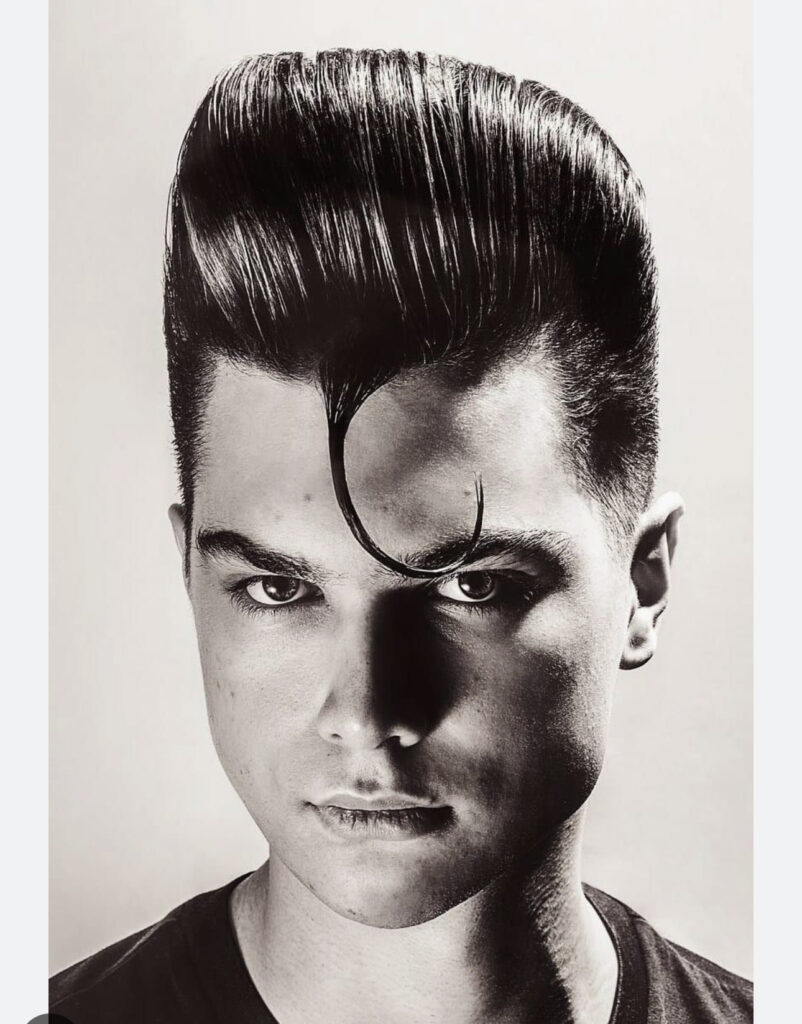
My Barbering Course – Competition Mood Board
and price winning award
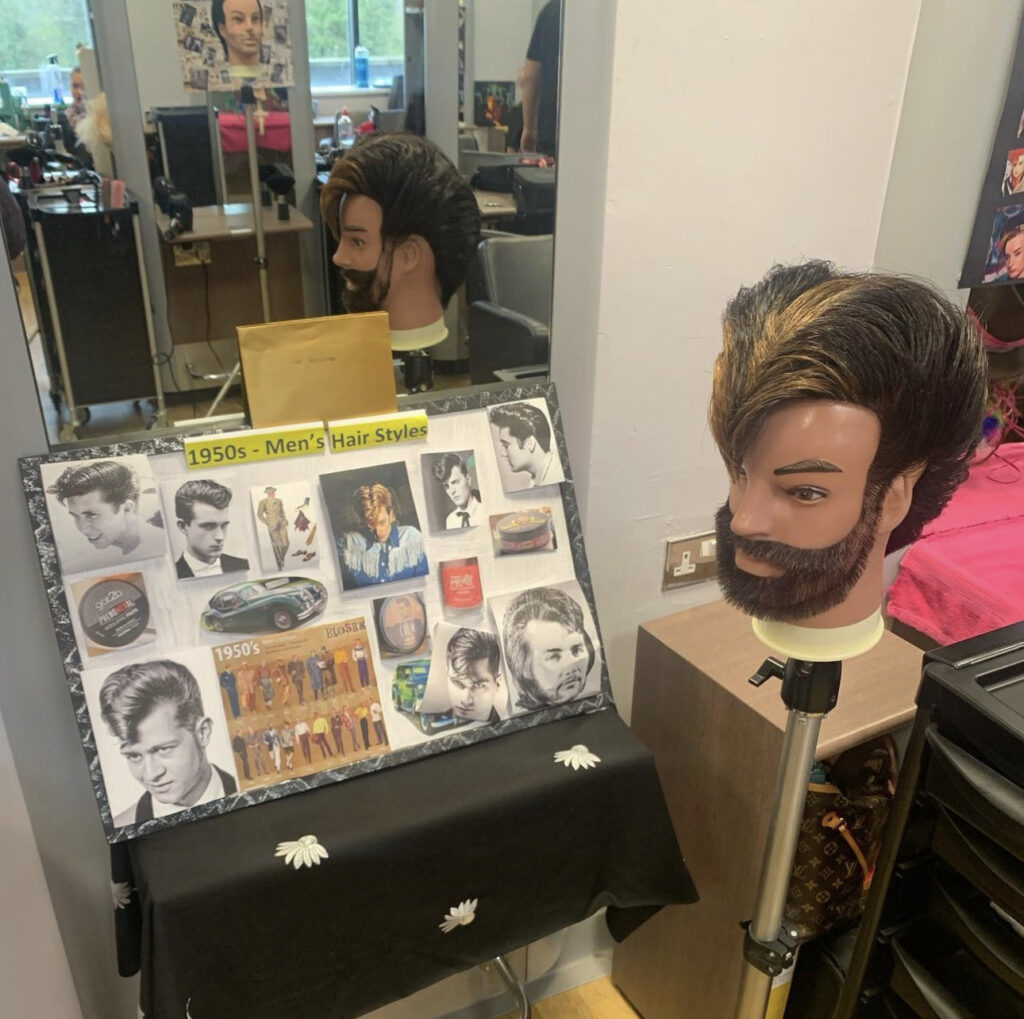
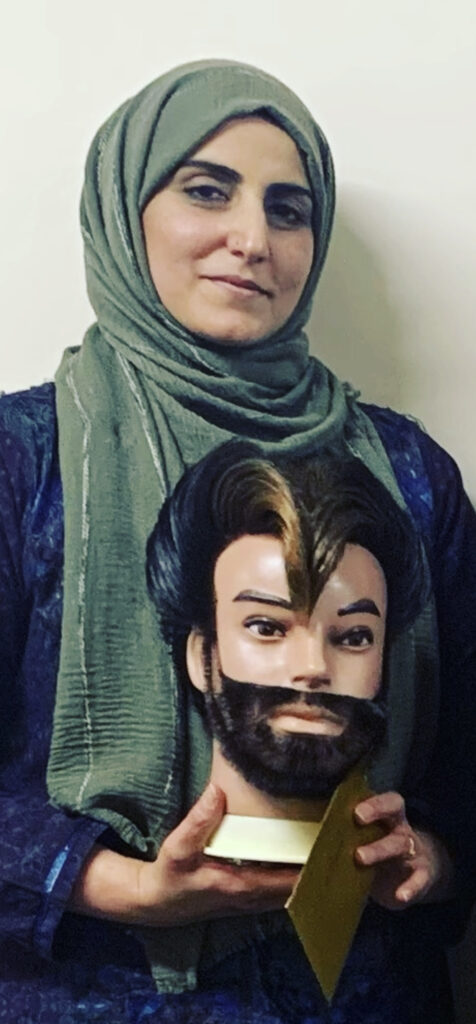

Male Grooming and Makeup/no makeup for TV and Film
To understand the importance of male grooming within Industry.
Create and utilise skills learnt to create a day/TV look using techniques shown by Lisa.
My model is my Husband for this demo, he suffers from Vitiligo (skin discoloration on his face and neck) I have tried to use colour corrective to even the tone to match the light to medium brown his natural skin shade and applied foundation lightly to give a natural look.
I have removed his facial and ears hair with the threading technique and used chargeable Trimmer around his neckline.
Before picture
Trimmed full head hair, shaped neck and around ears, with electric Clippers with comb no.3 at the bottom side and comb no.5 in mid head, then used scissors over comb and fingers for the top section of his head. and tidied hair around the neckline with trimmers, due to my husband suffers from vitiligo (skin discolouration) He gets lot of grey hair in beard and eye brows, so I applied permanent hair colour – XP – 4.77 colour shade chocolate brown (which is near to his natural colour shade) with 6% developer as his hair are really thick and 3% doesn’t work on his hair.
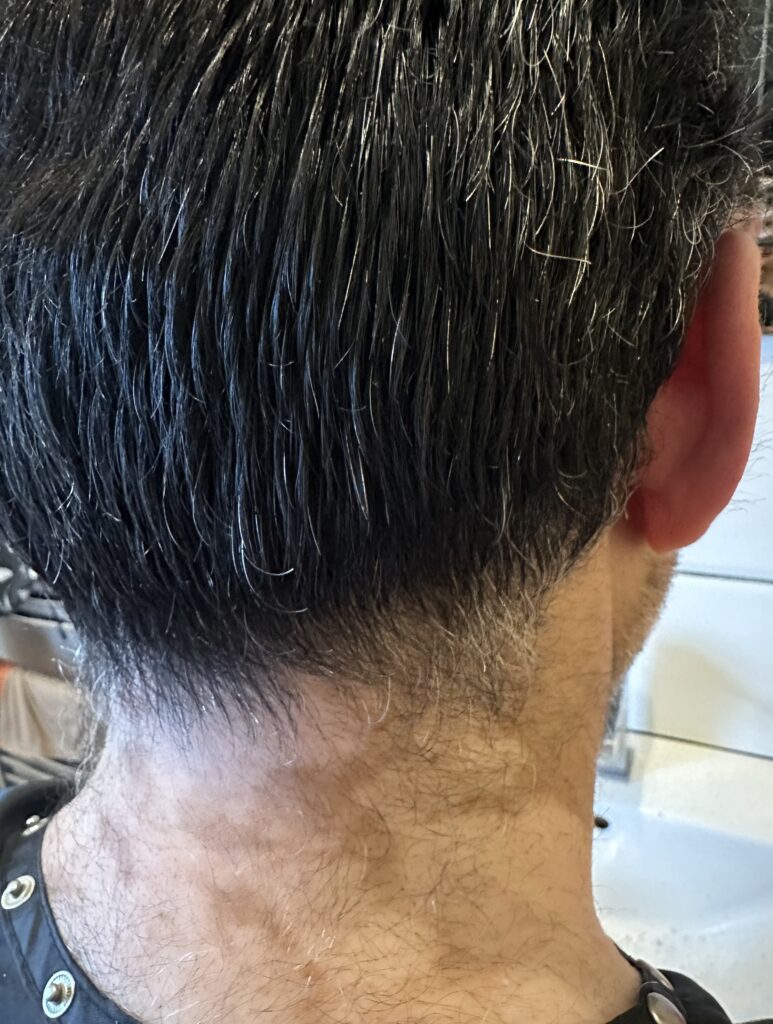
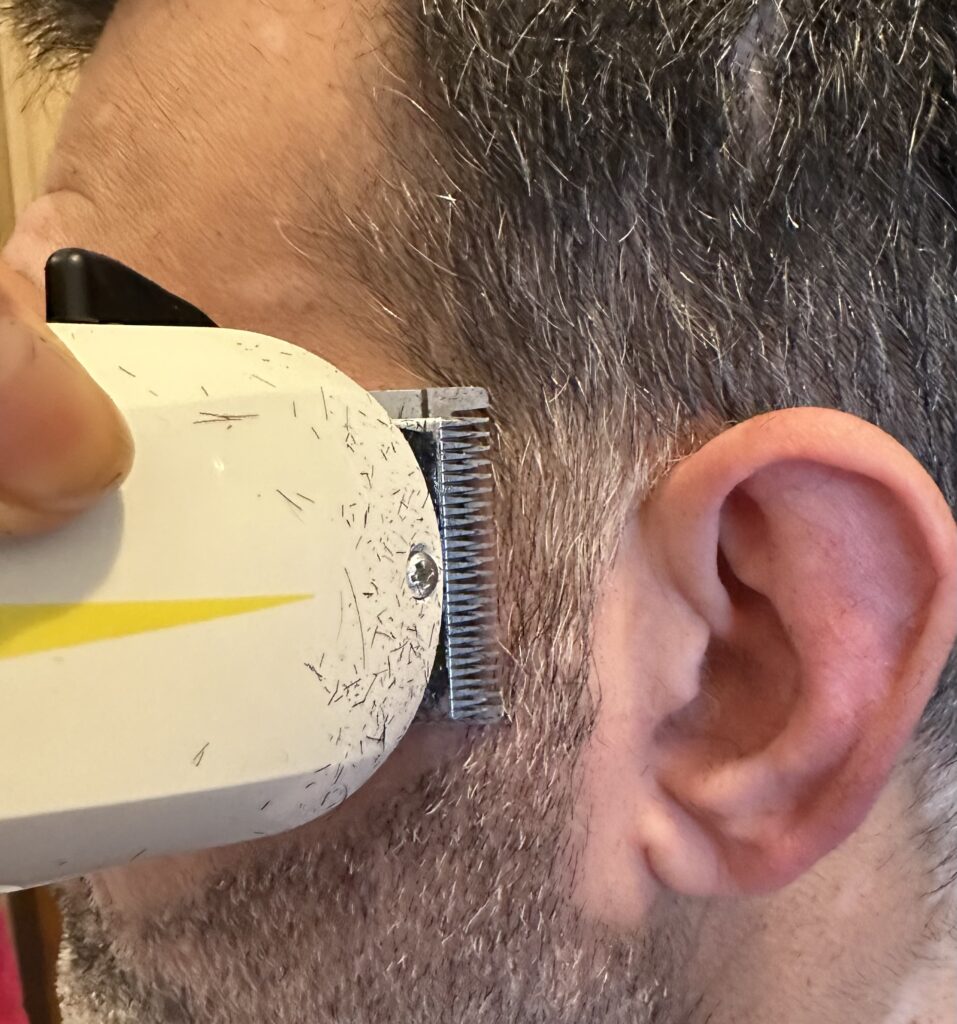
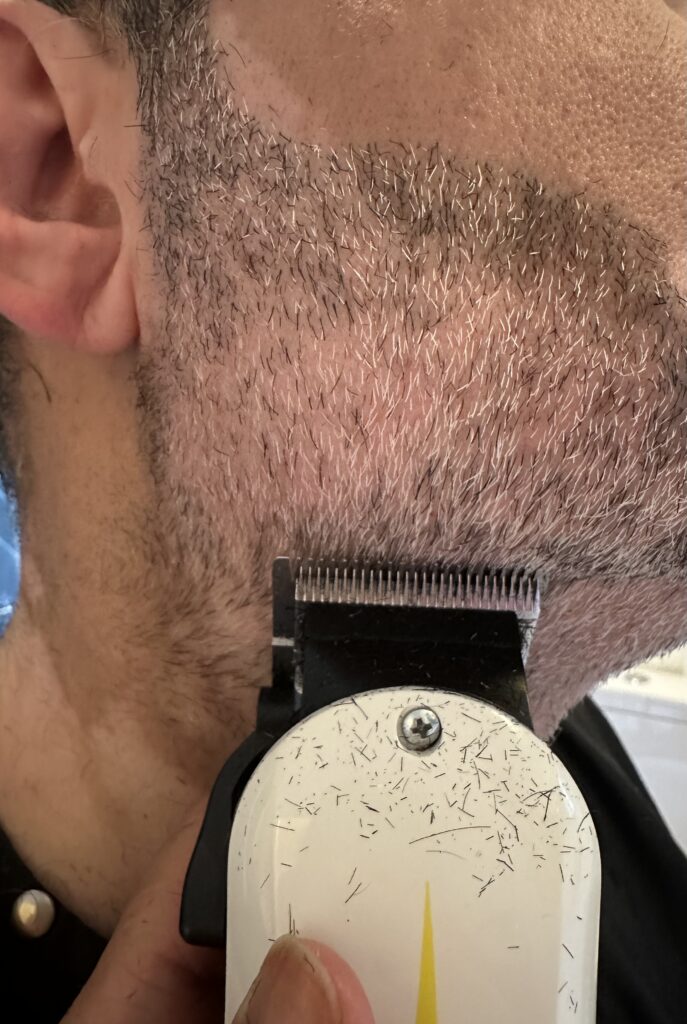
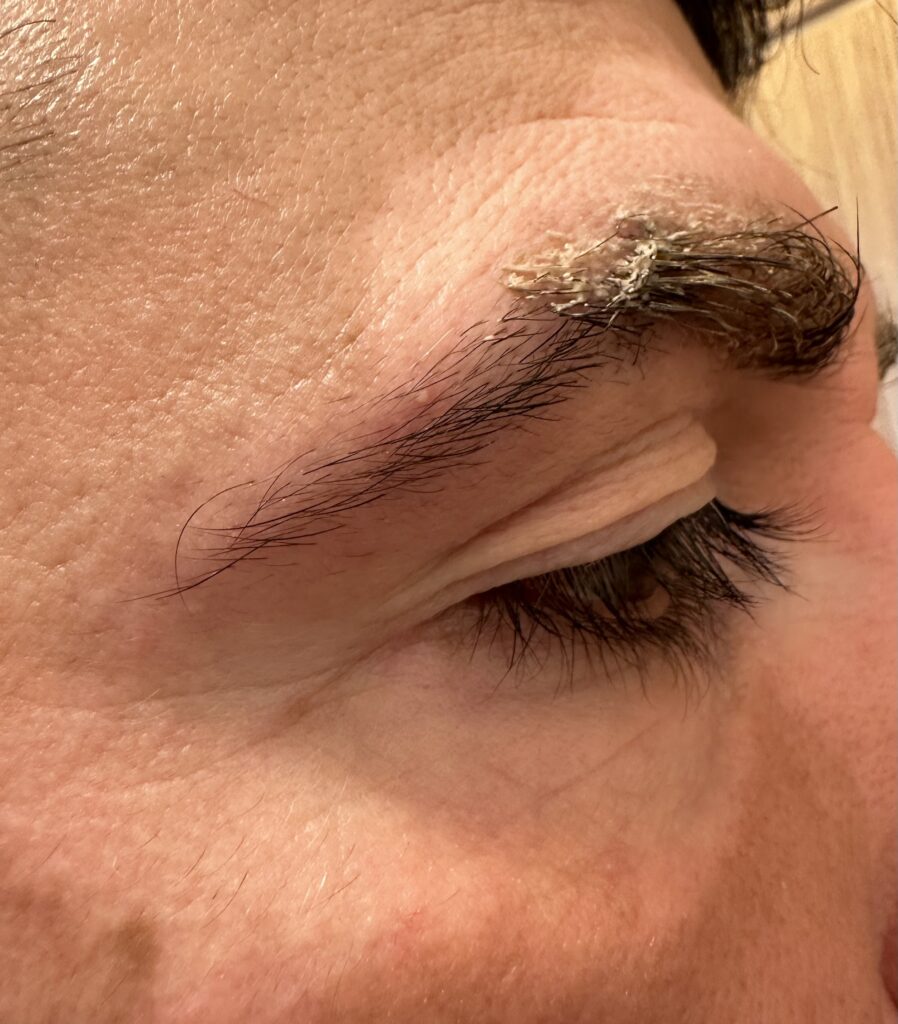
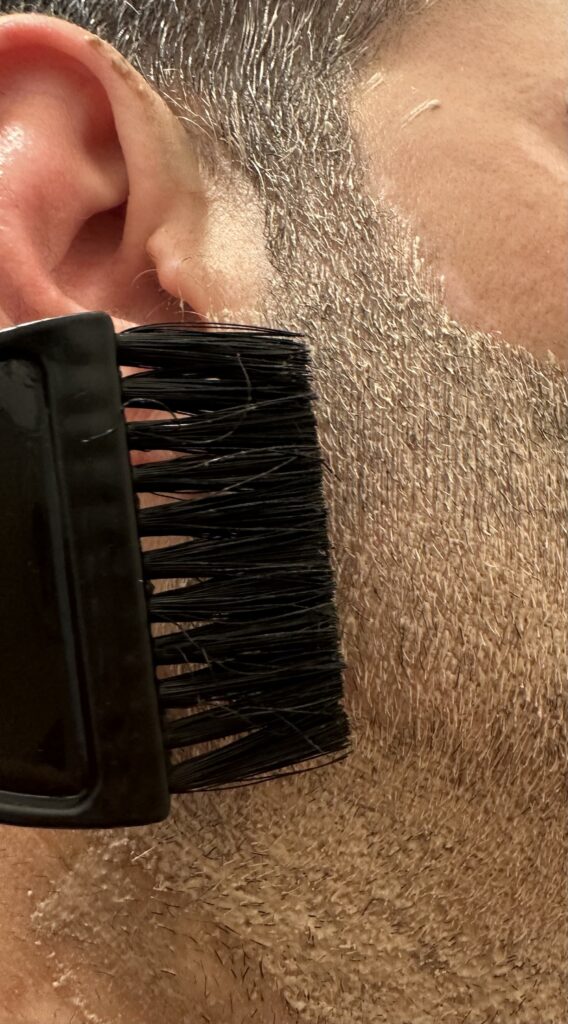

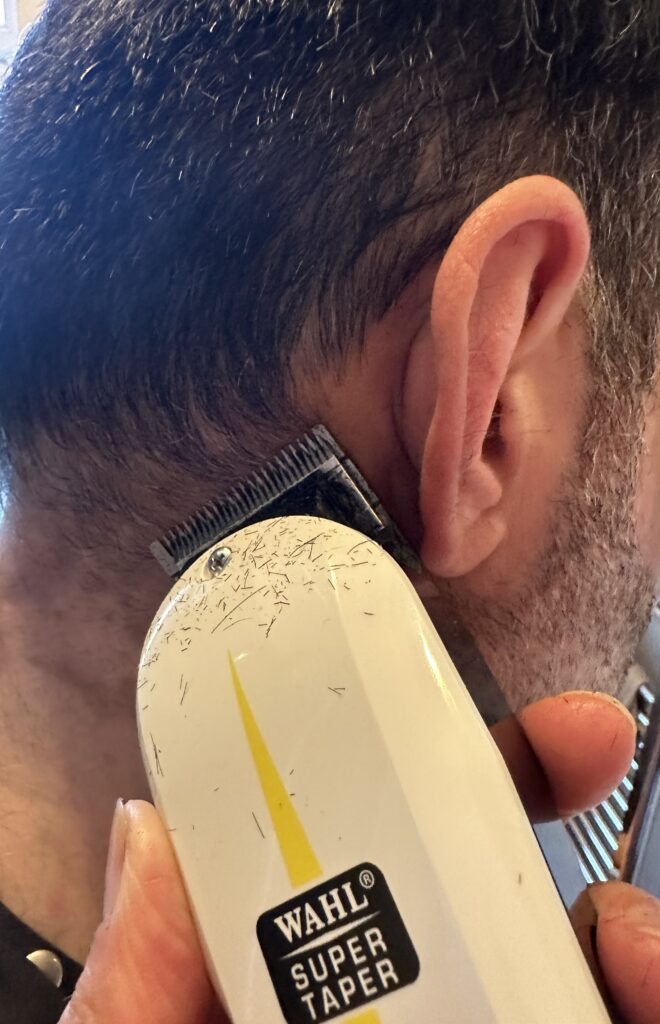
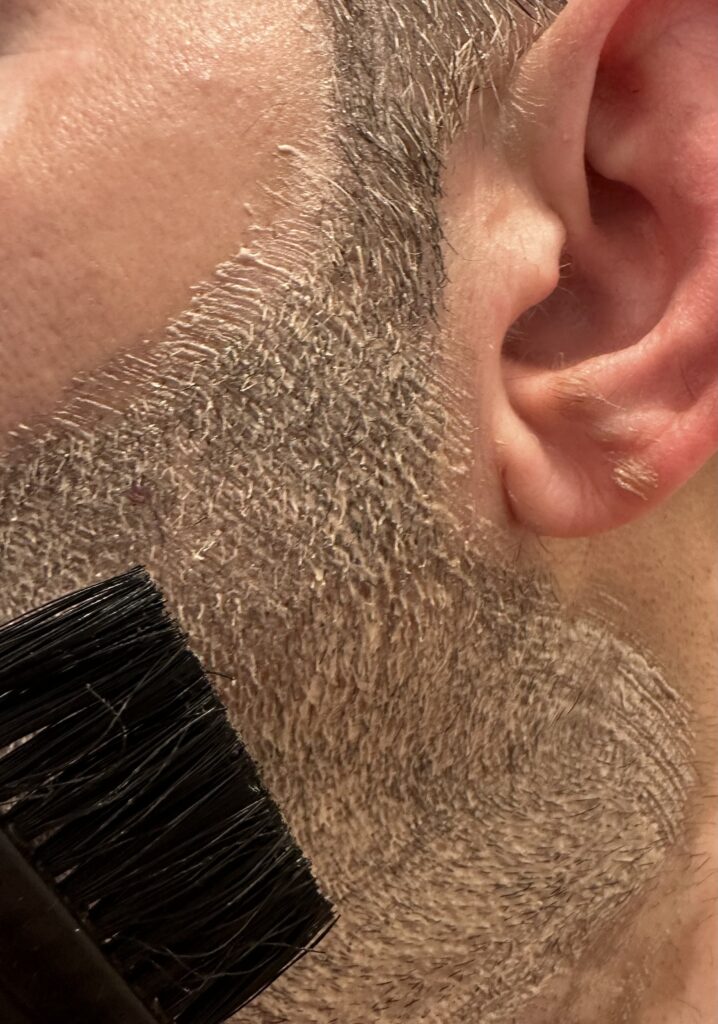
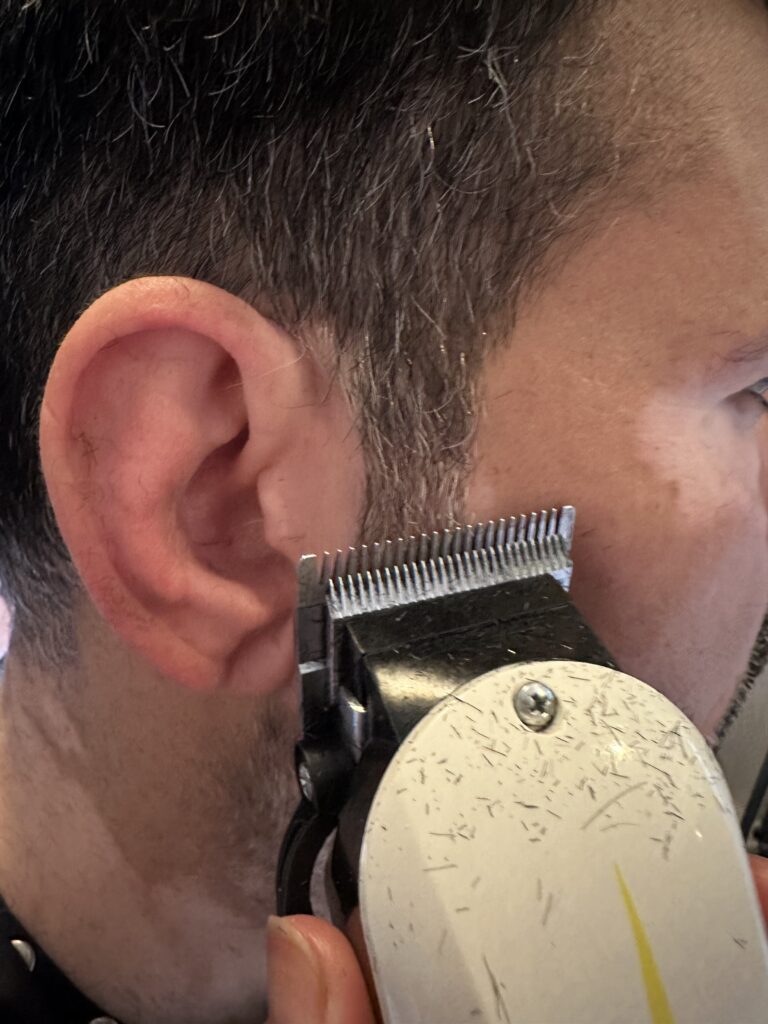
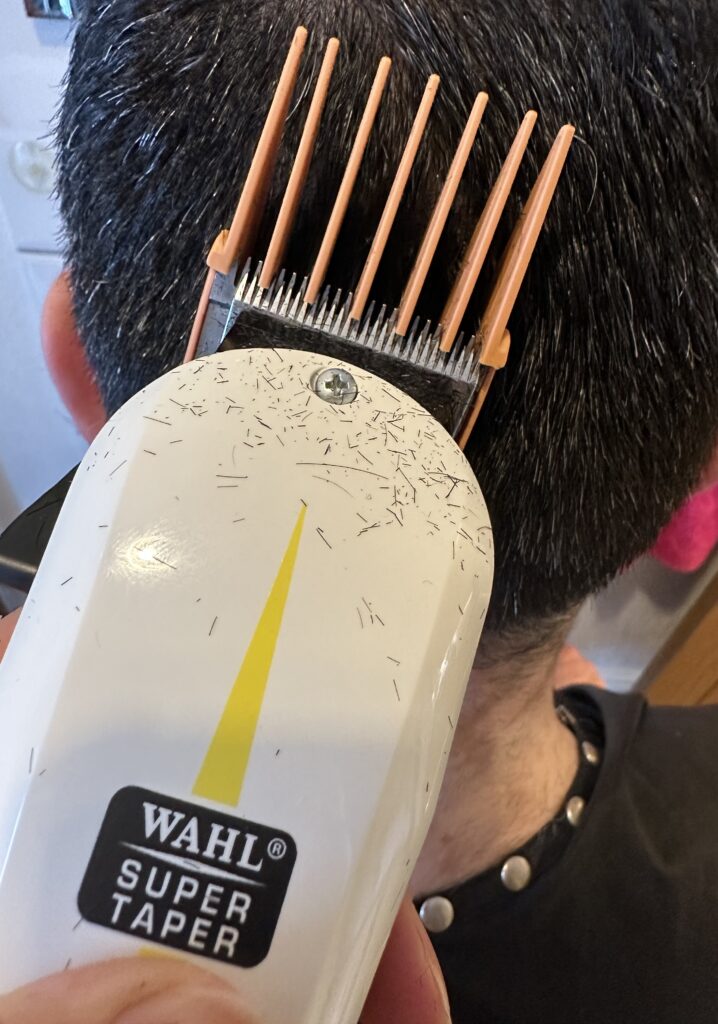
After Picture – coloured facial and hair trim and makeup just to cover white patches on top of eyebrows using orange colour corrector and applying Rimmel lipliner (in capuchins shade) He likes it look natural then full coverage cover
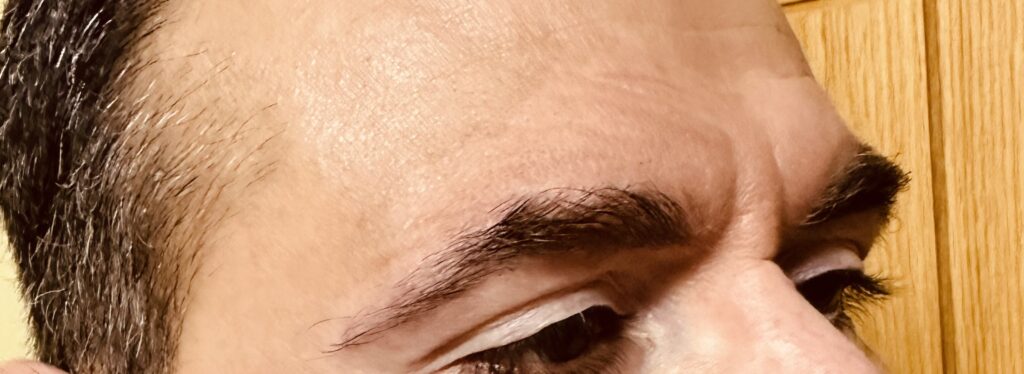
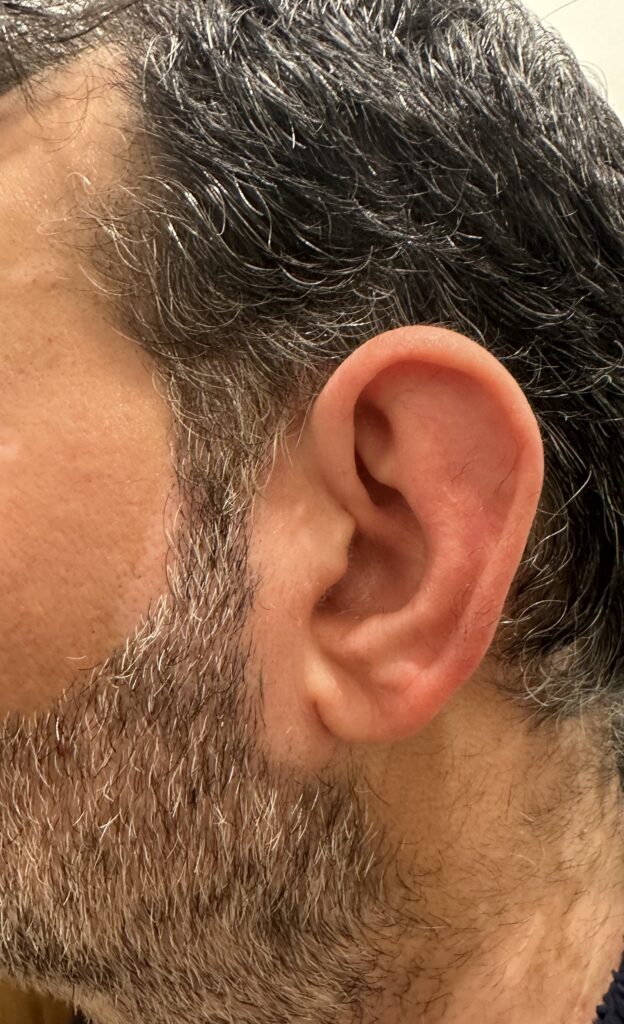
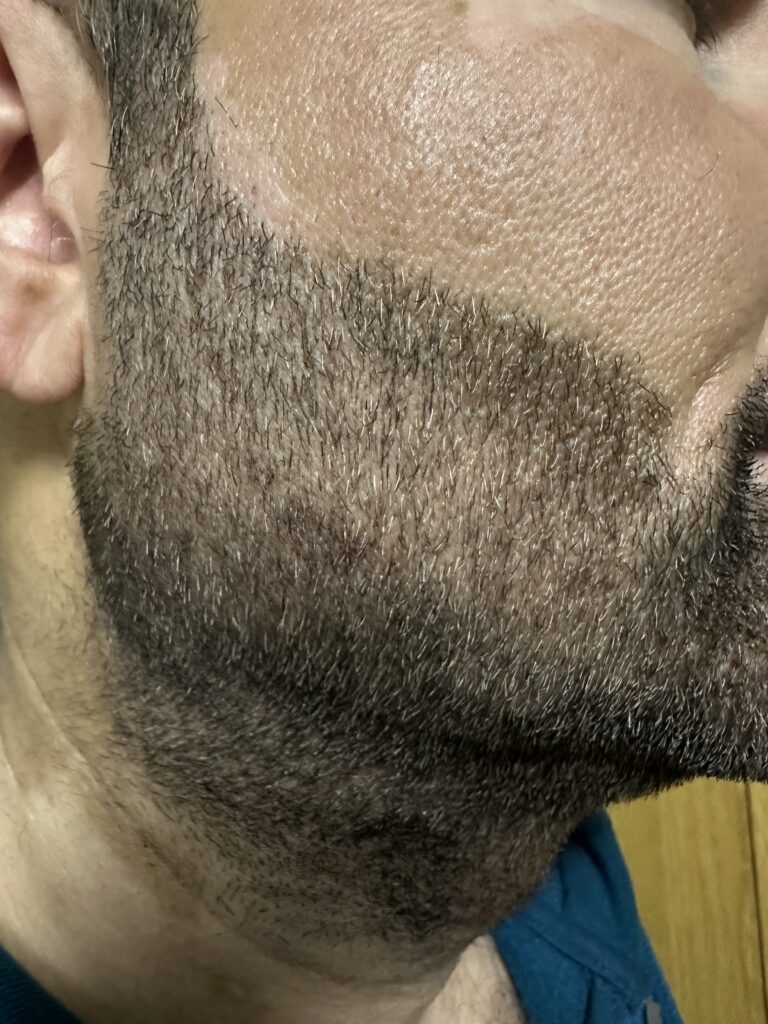
What is Vitiligo?


A condition in which the melanocytes, the pigment cells of the skin, are destroyed causing affected areas to turn pale. Often seen as patches of white skin.
Causes:
This is caused when pigment cells are destroyed or do not produce melanin, a color determinant of skin, hair and eyes. Know More
Symptoms:
White patches appear on skin parts like face, hands. Premature hair whitening including eyebrows, eyelids. Know More
Diagnosis:
Usually diagnosed by physical examination. Detailed medical history is taken to rule out other conditions such as dermatitis and psoriasis. Know More
Facts
Treatments can help manage condition, no known cure
Diagnosed by medical professional
Rarely requires lab test or imaging
Can last several years or be lifelong
Family history may increase likelihood
Know More
It is classified into 2 types: Non-segmental and segmental vitiligo.
- Non-segmental vitiligo: Most common type where the patches develop with symmetrical measure on both sides of the body. Appear on arms, eyes, back of the hands, mouth, knees.
Non-segmental vitiligo sub-categories include:
- Generalized vitiligo: No specific area or size of patches
- Acrofacial vitiligo: Occurs on fingers and toes.
- Mucosal vitiligo: Develops around mucosal membrane and lips.
- Universal vitiligo: Whole body is affected.
- Focal vitiligo: scattered patches in a specific area
- Segmental vitiligo: Non-symmetrical and affect areas of skin linked to nerves developing from spine dorsal roots.
Symptoms
CHARACTERISTIC
COMMON
Symptoms include:
White, well demarcated, oval macules and patches
Unpredictable rate of spread/enlargement of these patches
Premature whitening or graying of the hair, light hair color
Change in color inside mouth and nose
Causes
COMMON
Exact cause is not known but it is hereditary.
It is an auto immune disease wherein the immune system fight against our own cells that make pigment
It might show up due to stress, over exposure to sun or chemicals
Diagnosis
COMMON
Usually diagnosed by physical examination. Detailed medical history is taken to rule out other conditions such as dermatitis and psoriasis.
Affected skin biopsy is collected and examined.
Hgb levels and glucose levels are performed to check for anemia and diabetes.
Treatments
Treatment might help restore skin color to the affected parts but cannot cure the further loss of pigment cells.
Complications
Complications of vitiligo include the following:
- Depression
- Sensitivity of skin
- skin cancer
- Inflammation of the iris
Questions To Ask Your Doctor
- Is the condition curable?
- Any product to conceal the discoloured patches?
- Does this have any effect on my family members?
- Does this condition lead to any other complications?
Other products to use for male Hair and Skins
Beard oil is better for conditioning and moisturizing your facial hair, while balms are great for styling it. Beard oils are light in texture and easy to apply, whereas beard balms are thicker and have more hold that makes them ideal for shaping beards.
Anti Wrinkle serum, Luminating Men’s face cream, Nivea Men Sensitive Pro Menmalist Face Cream: Best no-frills face cream. …
The Grey 3-in-1 Face Cream: Best premium face cream. …
Aesop Elemental Facial Barrier Cream: Best face cream for winter. …
CeraVe Moisturising Cream: Best value face cream for dry skin.

Trimmers
Some full body trimmers come with multiple attachments (shout out to this 11-in-1 Wahl), so you can use a head that’s specifically designed for the body part you’re trying to tame. Look for these if you’d rather purchase one do-it-all device – the smart choice for smaller bathrooms and cabin bags.

Best Concealers for Men
- Make Up For Ever Ultra HD Self-Setting Concealer. …
- Dior Forever Skin Correct Concealer. …
- Tom Ford Concealing Pen. …
- Charlotte Tilbury Magic Away Concealer. …
- CoverGirl Clean Invisible Concealer. …
- Yves Saint Laurent All Hours Concealer.
Concealer

Concealer is similar to foundation except it’s generally thicker and hides dark circles, age spots, blemishes and more by hiding pigments and blending these imperfections into the skin. You should always apply concealer on top of your foundation so it doesn’t smudge.
Colour corrector

Color correctors are makeup or skin care [products] that you can use to correct discoloration, like sunspots or dark under-eye circles,” said celebrity makeup artist Andrew Sotomayor. “And the benefits of color correctors are that they have the opposite color of the discoloration.